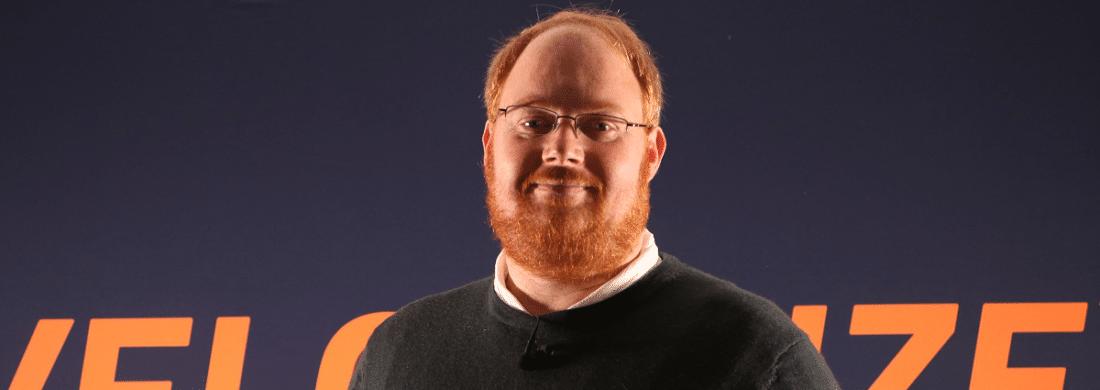You have an opportunity as a brand to define the kind of relationship that you want with your customer. The things that you do, the design decisions that you make, the way that you communicate, are going to be the things that shift the quality of the relationship from a good transaction to a bad transaction.
Andy Dobson is Head of Technology at Publicis•Poke, a creative agency helping clients explore inventive ways to build better customer relationships. Publicis•Poke combines storytelling, experience design and system thinking to help brands create ideas. Ideas that earn a place in everyday life, that live and breathe in culture, and that can grow and evolve over time.
In this episode of Velocitize Talks, Dobson shares his insights into the importance of storytelling and how brands can build authentic connections with customers.
Digital Divide (1:51)
Within the comms space, you’ve almost had a bit of tension between the digital—always moving, always evolving; and the traditional—the media plan and how to execute it.
During communication strategy planning, brands analyze different mediums to reach their customers. As mentioned earlier, tension between digital and traditional channels still exists. It is possible, however, to find that balance by analyzing a marketing campaign’s goals, target audience, message, time, and budget.
Some brands view traditional channels as labor intensive, requiring lots of time and manual processes. On the other hand, digital channels can seem too invasive or impersonal.
Although digital marketing formats have become the preferred method of communication, traditional outlets still play a role. Planning a marketing strategy that blends and leverages both systems is ideal for cultivating customer relationships.
What’s Your Story? (2:20)
I regard absolutely everything as a form of narrative and a form of storytelling. Even if we’re breaking things down into a very pragmatic or practical set of steps to get people what they want.
In Dobson’s view, everything is storytelling. That is what he sees the creative process doing—telling a story. Building up a gradual narrative is the ideal way for a brand to build a meaningful relationship with a customer.
The way that relationship translates into an ecommerce narrative is through a series of questions. What is this place? What am I trying to buy? What’s the offer? How do I find the things that I want?
“All of that is essentially a story that a brand is going to tell in the brand’s fashion,” Dobson says. He adds that the arc of a good story is crucial to a brand’s storytelling. Taking the time to plan out each narrative that creates an engaging story is vital for successful customer relationships.
Defining Relationships (3:42)
Our job happens at the interface between brand and customer: where they meet, wherever they meet.
As brands look to create brand affinity with their customers, it is important to define that relationship. Dobson points to things you can do in those spaces, including the design decisions as well as communications. In the end, those will be the things that make or break customer relationships. They’ll also be what defines and adds (or subtracts) value to your business.
An example of a brand defining their values is Publicis•Poke’s work with Renault to launch the new CLIO car. The work has been hailed as the best ad ever. Publicis•Poke used Renault’s long standing tagline ‘passion for life’ as a narrative to show a contemporary love story about two lifelong friends.
Publicis•Poke found “the overwhelmingly positive public response to the ad reinforced what we already knew to be true. We are all captivated by the power of brilliant storytelling.”
Viral Overload (6:42)
People don’t have an affinity for a marketing campaign. But they do have an affinity for a really good story or a really engaging piece of creative work.
Many marketers have dreams of their content taking off, perhaps even going viral. As a content-creating community focused on viral content, it’s tough to pull back. Brands need to identify what a customer is truly looking for from their content. Dobson says that when it comes to engaging people, “it’s what catches their eye or the thing that provokes curiosity.”
People are looking for content that moves, touches, or connects with them. Depending on your audience, though, they may or may not care about your content so it’s important to remain objective.
Kill Your Social Media? (13:07)
The chasing after engagement that we have been doing for the last 20 years…is not working for us as a society.
Hyperconnectedness. Manipulation. Threat to society. Although people continue to blame social media for many issues, marketers realize the benefits in their media strategy. But the slow drumbeat of criticism toward the medium is echoing loudly—some from the same people who created it.
The author, Jaron Lanier, is an early Silicon Valley pioneer. He wrote “Ten Arguments for Deleting Your Social Media Accounts Right Now,” which synthesizes algorithms in technology. And it’s the book that Dobson just finished.
“I think Jared Lanier’s book allows you to take a very objective look at individual platforms,” Dobson says. “I think what that encourages us to do, without judgment, is ask ourselves how we would design a good relationship.”
For more information on Publicis•Poke, check out their website, follow them on LinkedIn, Instagram or Twitter at @publicispoke. To stay up to date with Dobson, follow him on LinkedIn and Twitter at @andrewdotdobson.
This episode of Velocitize Talks was originally recorded in London in 2019 and has been updated accordingly.
